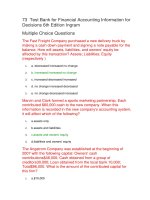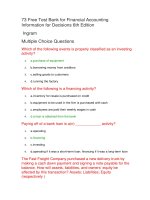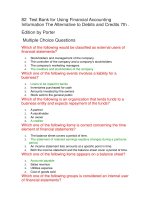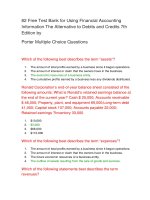208 test bank for financial accounting 9th edition
Bạn đang xem bản rút gọn của tài liệu. Xem và tải ngay bản đầy đủ của tài liệu tại đây (247.57 KB, 60 trang )
208 Test Bank for Financial Accounting 9th Edition
True - False Questions
The Financial Accounting Standards Board is a part of the Securities and
Exchange Commission.
1.
True
2.
False
Net income for the period is determined by subtracting total expenses and
drawings from total revenues.
1.
True
2.
False
At the time an asset is acquired, cost and fair value should be the same.
1.
True
2.
False
In the retained earnings statement, revenues are listed first, followed by
expenses, and net income (or net loss).
1.
True
2.
False
The primary accounting standard-setting body in the United States is the
International Accounting Standards Board.
1.
True
2.
False
The basic accounting equation states that Assets = Liabilities.
1.
True
2.
False
Even though a partnership is not a separate legal entity, for accounting
purposes the partnership affairs should be kept separate from the personal
activities of the owners.
1.
True
2.
False
Accountants rely on a fundamental business concept—ethical behavior—in
reporting financial information.
1.
True
2.
False
The study of accounting is not useful for a business career unless your career
objective is to become an accountant.
1.
True
2.
False
A working knowledge of accounting is not relevant to a lawyer or an architect.
1.
True
2.
False
Private accountants are accountants who are not employees of business
enterprises.
1.
True
2.
False
Identifying is the process of keeping a chronological diary of events
measured in dollars and cents.
1.
True
2.
False
The hiring of a new company president is an economic event recorded by the
financial information system.
1.
True
2.
False
Accounting communicates financial information about a business enterprise
to both internal and external users.
1.
True
2.
False
The monetary unit assumption states that transactions that can be measured
in terms of money should be recorded in the accounting records.
1.
True
2.
False
The ending retained earnings balance is reported on both the retained
earnings statement and the balance sheet.
1.
True
2.
False
Accountants do not have to worry about issues of ethics.
1.
True
2.
False
The purchase of store equipment for cash reduces stockholders’ equity by an
equal amount.
1.
True
2.
False
External transactions involve economic events between the company and
some other enterprise or party.
1.
True
2.
False
Expressing an opinion as to the fairness of the information presented in
financial statements is a service performed by CPAs.
1.
True
2.
False
Internal transactions do not affect the basic accounting equation because
they are economic events that occur entirely within one company.
1.
True
2.
False
Owners' claims to total business assets take precedence over the claims of
creditors because owners invest assets in the business and are liable for
losses.
1.
True
2.
False
The monetary unit assumption requires that all dollar amounts be rounded to
the nearest dollar.
1.
True
2.
False
A partnership must have more than one owner.
1.
True
2.
False
Financial statements are the major means of communicating accounting
information to interested parties.
1.
True
2.
False
The economic entity assumption requires that the activities of an entity be
kept separate and distinct from the activities of its owner and all other
economic entities.
1.
True
2.
False
Management of a business enterprise is the major external user of
information.
1.
True
2.
False
The study of accounting will be useful only if a student is interested in
working for a profit-oriented business firm.
1.
True
2.
False
A balance sheet reports the assets and liabilities of a company for a specific
period of time.
1.
True
2.
False
The cost and fair value of an asset are the same at the time of acquisition and
in all subsequent periods.
1.
True
2.
False
The origins of accounting are attributed to Luca Pacioli, a famous
mathematician.
1.
True
2.
False
The primary purpose of the statement of cash flows is to provide information
about the cash receipts and cash payments of a company during a period.
1.
True
2.
False
Accounting information is used only by external users with a financial interest
in a business enterprise.
1.
True
2.
False
The Securities and Exchange Commission oversees U.S. financial markets
and accounting standard-setting bodies.
1.
True
2.
False
Accountants record both internal and external transactions.
1.
True
2.
False
Owners of business firms are the only people who need accounting
information.
1.
True
2.
False
Management consulting includes examining the financial statements of
companies and expressing an opinion as to the fairness of their presentation.
1.
True
2.
False
The purchase of office equipment on credit increases total assets and total
liabilities.
1.
True
2.
False
The basic accounting equation is in balance when the creditor and ownership
claims against the business equal the assets.
1.
True
2.
False
Bookkeeping and accounting are one and the same because the bookkeeping
function includes the accounting process.
1.
True
2.
False
Transactions that can be measured in dollars and cents are recorded in the
financial information system.
1.
True
2.
False
In order to possess future service potential, an asset must have physical
substance.
1.
True
2.
False
The income statement is sometimes referred to as the statement of
operations.
1.
True
2.
False
Multiple Choice Questions - Page 1
The SEC and FASB are two organizations that are primarily responsible for
establishing generally accepted accounting principles. It is true that
1.
a.they are both governmental agencies.
2.
b.the SEC is a private organization of accountants.
3.
c.the SEC often mandates guidelines when no accounting principles exist.
4.
d.the SEC and FASB rarely cooperate in developing accounting standards.
Communication of economic events is the part of the accounting process that
involves
1.
a.identifying economic events.
2.
b.quantifying transactions into dollars and cents.
3.
c.preparing accounting reports.
4.
d.recording and classifying information.
Which of the following techniques are not used by accountants to interpret
and report financial information?
1.
a.Graphs.
2.
b.Special memos for each class of external users.
3.
c.Charts.
4.
d.Ratios.
The private sector organization involved in developing accounting principles
is the
1.
a.Feasible Accounting Standards Body.
2.
b.Financial Accounting Studies Board.
3.
c.Financial Accounting Standards Board.
4.
d.Financial Auditors' Standards Body.
The economic entity assumption requires that the activities
1.
a.of different entities can be combined if all the entities are corporations.
2.
b.must be reported to the Securities and Exchange Commission.
3.
c.of a sole proprietorship cannot be distinguished from the personal economic events
of its owners.
4.
d.of an entity be kept separate from the activities of its owner.
The accounting process involves all of the following except
1.
a.identifying economic transactions that are relevant to the business.
2.
b.communicating financial information to users by preparing financial reports.
3.
c.recording nonquantifiable economic events.
4.
d.analyzing and interpreting financial reports.
Which one of the following is not an external user of accounting information?
1.
a.Regulatory agencies.
2.
b.Customers.
3.
c.Investors.
4.
d.All of these are external users.
The historical cost principle requires that when assets are acquired, they be
recorded at
1.
a.appraisal value.
2.
b.cost.
3.
c.market price.
4.
d.book value.
Which of the following would not be considered an external user of
accounting data for the GHI Company?
1.
a.Internal Revenue Service Agent.
2.
b.Management.
3.
c.Creditors.
4.
d.Customers.
The fair value principle is applied for
1.
a.all assets.
2.
b.current assets.
3.
c.buildings.
4.
d.investment securities.
The final step in solving an ethical dilemma is to
1.
a.identify and analyze the principal elements in the situation.
2.
b.recognize an ethical situation.
3.
c.identify the alternatives and weigh the impact of each alternative on stakeholders.
4.
d.recognize the ethical issues involved.
The cost of an asset and its fair value are
1.
a.never the same.
2.
b.the same when the asset is sold.
3.
c.irrelevant when the asset is used by the business in its operations.
4.
d.the same on the date of acquisition.
All of the following are steps in analyzing ethics cases in financial reporting
except
1.
a.identify and analyze the principle elements in the situation.
2.
b.contact law enforcement regarding any violations of corporate ethics codes
3.
c.identify the alternatives and weigh the impact of each alternative on various
stakeholders.
4.
d.recognize an ethical situation and the ethical issues involved.
Andre Dickinson, owner of Andre's Fine Wines, also owns a personal
residence that costs $475,000. The market value of his residence is $625,000.
During preparation of the financial statements for Andre's Fine Wines, the
accounting concept most relevant to the presentation of Andre's home is
1.
a.the economic entity assumption.
2.
b.the fair value principle.
3.
c.the monetary unit assumption.
4.
d.convergence.
The proprietorship form of business organization
1.
a.must have at least three owners in most states.
2.
b.represents the largest number of businesses in the United States.
3.
c.combines the records of the business with the personal records of the owner.
4.
d.is characterized by a legal distinction between the business as an economic unit and
the owner.
Financial accounting provides economic and financial information for all of
the following except
1.
a.creditors.
2.
b.investors.
3.
c.managers.
4.
d.other external users.
In order to increase comparability, in recent years, the FASB and IASB have
made efforts to reduce the differences between U.S.GAAP and IFRS through a
process known as
1.
a.convergence
2.
b.monetary unit assumption
3.
c.the cost principle
4.
d.the fair value principle
A business organized as a corporation
1.
a.is not a separate legal entity in most states.
2.
b.requires that stockholders be personally liable for the debts of the business.
3.
c.is owned by its stockholders.
4.
d.terminates when one of its original stockholders dies.
Bookkeeping differs from accounting in that bookkeeping primarily involves
which part of the accounting process?
1.
a.Identification.
2.
b.Communication.
3.
c.Recording.
4.
d.Analysis.
Which of the following is an external user of accounting information?
1.
a.Labor unions.
2.
b.Finance directors.
3.
c.Company officers.
4.
d.Managers.
Financial information that is capable of making a difference in a decision is
1.
a.faithfully representative.
2.
b.relevant.
3.
c.convergent.
4.
d.generally accepted.
The origins of accounting are generally attributed to the work of
1.
a.Christopher Columbus.
2.
b.Abner Doubleday.
3.
c.Luca Pacioli.
4.
d.Leonardo da Vinci.
The Duce Company has five plants nationwide that cost a total of $100 million.
The current fair value of the plants is $500 million. The plants will be recorded
and reported as assets at
1.
a.$100 million.
2.
b.$600 million.
3.
c.$400 million.
4.
d.$500 million.
The process of recording transactions has become more efficient because
1.
a.fewer events can be quantified in financial terms.
2.
b.computers are used in processing business events.
3.
c.more people have been hired to record business transactions.
4.
d.business events are recorded only at the end of the year.
Which of the following events cannot be quantified into dollars and cents and
recorded as an accounting transaction?
1.
a.The appointment of a new CPA firm to perform an audit.
2.
b.The purchase of a new computer.
3.
c.The sale of store equipment.
4.
d.Payment of income taxes.
Accountants refer to an economic event as a
1.
a.purchase.
2.
b.sale.
3.
c.transaction.
4.
d.change in ownership.
The use of computers in recording business events
1.
a.has made the recording process more efficient.
2.
b.does not use the same principles as manual accounting systems.
3.
c.has greatly impacted the identification stage of the accounting process.
4.
d.is economical only for large businesses.
Which of the following would not be considered an internal user of accounting
data for the GHI Company?
1.
a.President of the company.
2.
b.Production manager.
3.
c.Merchandise inventory clerk.
4.
d.President of the employees' labor union.
The partnership form of business organization
1.
a.is a separate legal entity.
2.
b.is a common form of organization for service-type businesses.
3.
c.enjoys an unlimited life.
4.
d.has limited liability.
Accounting consists of three basic activities which are related to economic
events of an organization. These include
1.
a.identifying, recording, and communicating
2.
b.identifying, calculating, and responding
3.
c.classifying, numbering, and reporting
4.
d.issuing, reporting, and classifying
The body of theory underlying accounting is not based on
1.
a.physical laws of nature.
2.
b.concepts.
3.
c.principles.
4.
d.definitions.
Generally accepted accounting principles are
1.
a.income tax regulations of the Internal Revenue Service.
2.
b.standards that indicate how to report economic events.
3.
c.theories that are based on physical laws of the universe.
4.
d.principles that have been proven correct by academic researchers.
Martin Corporation purchased land in 2007 for $290,000. In 2015, it purchased
a nearly identical parcel of land for $460,000. In its 2015 balance sheet, Martin
valued these two parcels of land at a combined value of $920,000. By
reporting the land in this manner, Martin Corp. has violated the
1.
a.historical cost principle
2.
b.convergence
3.
c.economic entity assumption
4.
d.monetary unit assumption
The accounting process is correctly sequenced as
1.
a.identification, communication, recording.
2.
b.recording, communication, identification.
3.
c.identification, recording, communication.
4.
d.communication, recording, identification.
All of the following statements are correct except
1.
a.Good decision-making depends on good information.
2.
b.A vital element in communicating economic events is the accountant's ability to
analyze and interpret reported information.
3.
c.The origins of accounting are generally attributed to Socrates, a classical Greek
philosopher, who promoted accounting as a social contract.
4.
d.The information that a user of financial information needs depends upon the kinds of
decisions the user makes.
GAAP stands for
1.
a.Generally Accepted Auditing Procedures.
2.
b.Generally Accepted Accounting Principles.
3.
c.Generally Accepted Auditing Principles.
4.
d.Generally Accepted Accounting Procedures.
The first step in solving an ethical dilemma is to
1.
a.identify and analyze the principal elements in the situation.
2.
b.identify the alternatives.
3.
c.recognize an ethical situation and the ethical issues involved.
4.
d.weigh the impact of each alternative on various stakeholders.
Which of the following would not be considered internal users of accounting
data for a company?
1.
a.The president of a company.
2.
b.The controller of a company.
3.
c.Creditors of a company.
4.
d.Salesmen of the company.
Ethics are the standards of conduct by which one's actions are judged as
1.
a.right or wrong.
2.
b.honest or dishonest.
3.
c.fair or unfair.
4.
d.All of these answers are correct.
148 Free Test Bank for Financial Accounting 9th Edition
by Weygandt Multiple Choice Questions - Page 2
The assumption that the unit of measure remains sufficiently constant over
time is part of the
1.
a.economic entity assumption.
2.
b.cost principle.
3.
c.historical cost principle.
4.
d.monetary unit assumption.
Liabilities of a company are owed to
1.
a.debtors.
2.
b.benefactors.
3.
c.creditors.
4.
d.underwriters.
Stockholders' equity is decreased by all of the following except
1.
a.sales of stock.
2.
b.net losses.
3.
c.expenses.
4.
d.dividends.
The accounting equation for Quattro Enterprises is as follows:
AssetsLiabilitiesStockholders' Equity $120,000=$60,000+$60,000; If Quattro
purchases office equipment on account for $25,000, the accounting equation
will change to AssetsLiabiltiesStockholders' Equity
1.
a.$120,000 = $60,000 +$60,000
2.
b.$145,000 = $60,000 +$85,000
3.
c.$145,000 = $72,500 +$72,500
4.
d.$145,000 = $85,000 +$60,000
Owner's equity is best depicted by the following:
1.
a.Assets = Liabilities.
2.
b.Liabilities + Assets.
3.
c.Residual equity + Assets.
4.
d.Assets – Liabilities.
The common characteristic possessed by all assets is
1.
a.long life.
2.
b.great monetary value.
3.
c.tangible nature.
4.
d.future economic benefit.
When assets are distributed to the owners of a corporation, these
distributions are termed
1.
a.depletions.
2.
b.consumptions.
3.
c.dividends.
4.
d.a credit line.
The basic accounting equation cannot be restated as
1.
a.Assets – Liabilities = Stockholders' Equity.
2.
b.Assets – Stockholders' Equity = Liabilities.
3.
c.Stockholders' Equity + Liabilities = Assets.
4.
d.Assets + Liabilities = Stockholders' Equity.
If total liabilities increased by $25,000 during a period of time and
stockholders' equity decreased by $9,000 during the same period, then the
amount and direction (increase or decrease) of the period’s change in total
assets is a(n)
1.
a.$34,000 decrease.
2.
b.$16,000 decrease.
3.
c.$16,000 increase.
4.
d.$34,000 increase.
Ted Leo is the proprietor (owner) of Ted's, a retailer of golf apparel. When
recording the financial transactions of Ted's, Ted does not record an entry for
a car he purchased for personal use. Ted took out a personal loan to pay for
the car. What accounting concept guides Ted's behavior in this situation?
1.
a.Pay back concept
2.
b.Economic entity assumption
3.
c.Cash basis concept
4.
d.Monetary unit assumption
The basic accounting equation may be expressed as
1.
a.Assets = Equities.
2.
b.Assets – Liabilities = Stockholders' Equity.
3.
c.Assets = Liabilities + Stockholders' Equity.
4.
d.All of these answers are correct.
Sources of increases to stockholder's equity are
1.
a.additional investments by owners.
2.
b.purchases of merchandise.
3.
c.dividends.
4.
d.expenses.
Which of the following is true regarding the corporate form of business
organization?
1.
a.Corporations are the most prevalent form of business organization.
2.
b.Corporate businesses are generally smaller in size than partnerships and proprietorships.
3.
c.The revenues of corporations are greater than the combined revenues of
partnerships and proprietorships.
4.
d.Corporations are separate legal entities organized exclusively under federal law.
John and Sam met at law school and decide to start a small law practice after
graduation. They agree to split revenues and expenses evenly. The most
common form of business organization for a business such as this would be
a
1.
a.joint venture.
2.
b.partnership.
3.
c.corporation.
4.
d.proprietorship.









